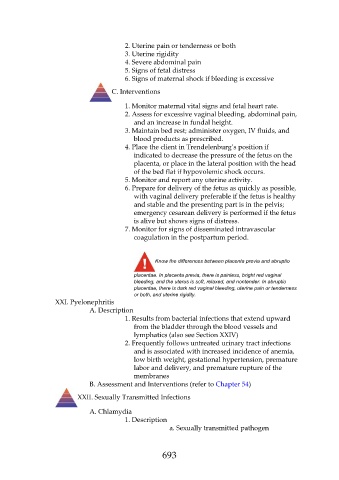Page 693 - Saunders Comprehensive Review For NCLEX-RN
P. 693
2. Uterine pain or tenderness or both
3. Uterine rigidity
4. Severe abdominal pain
5. Signs of fetal distress
6. Signs of maternal shock if bleeding is excessive
C. Interventions
1. Monitor maternal vital signs and fetal heart rate.
2. Assess for excessive vaginal bleeding, abdominal pain,
and an increase in fundal height.
3. Maintain bed rest; administer oxygen, IV fluids, and
blood products as prescribed.
4. Place the client in Trendelenburg’s position if
indicated to decrease the pressure of the fetus on the
placenta, or place in the lateral position with the head
of the bed flat if hypovolemic shock occurs.
5. Monitor and report any uterine activity.
6. Prepare for delivery of the fetus as quickly as possible,
with vaginal delivery preferable if the fetus is healthy
and stable and the presenting part is in the pelvis;
emergency cesarean delivery is performed if the fetus
is alive but shows signs of distress.
7. Monitor for signs of disseminated intravascular
coagulation in the postpartum period.
Know the differences between placenta previa and abruptio
placentae. In placenta previa, there is painless, bright red vaginal
bleeding, and the uterus is soft, relaxed, and nontender. In abruptio
placentae, there is dark red vaginal bleeding, uterine pain or tenderness
or both, and uterine rigidity.
XXI. Pyelonephritis
A. Description
1. Results from bacterial infections that extend upward
from the bladder through the blood vessels and
lymphatics (also see Section XXIV)
2. Frequently follows untreated urinary tract infections
and is associated with increased incidence of anemia,
low birth weight, gestational hypertension, premature
labor and delivery, and premature rupture of the
membranes
B. Assessment and Interventions (refer to Chapter 54)
XXII. Sexually Transmitted Infections
A. Chlamydia
1. Description
a. Sexually transmitted pathogen
693

